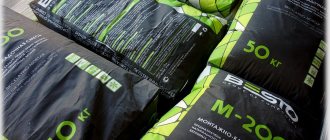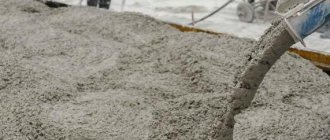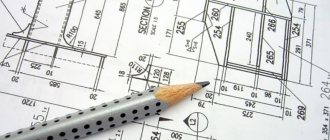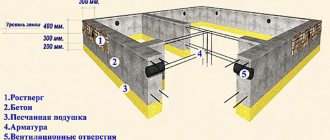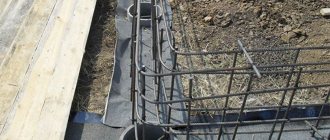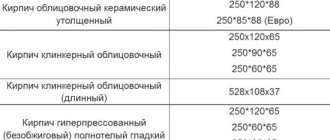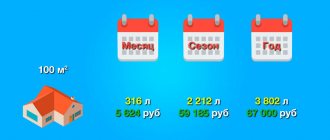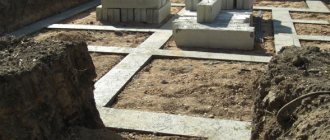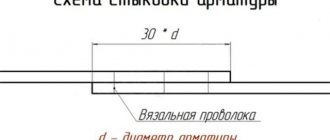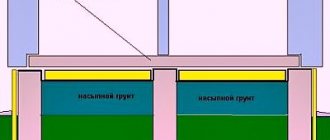In concrete, cement is the compound that binds all its components. The technical characteristics of the solution depend on its quantity and quality - strength, frost resistance, water resistance, corrosion resistance. As part of the mixture, the price for it is the highest, so the issue of cement consumption per 1 cubic meter of concrete is acute - too much, the profitability of construction will decrease, cracks will appear after hardening, too little - the required technical and operational characteristics will not be achieved.
What does consumption depend on?
The main requirement for concrete is to achieve the required strength after hardening. Based on this, in accordance with construction standards describing the quality of components, their ratio and technical characteristics are selected. This is done taking into account the strength grade of the composition; the recommended ratio of ingredients is indicated in specialized reference books. To calculate how much cement will be contained in 1 m³ of concrete, the following factors are taken into account:
- brand, density, required setting time;
- plasticity of the solution and its mobility;
- type of sand, fraction, presence of impurities, the proportion of which does not exceed 15%, otherwise this filler is subjected to pre-treatment - sifting or washing;
- fraction, type and other technical characteristics of crushed stone - flakiness, density, contamination, if it exceeds the norm, the crushed stone is cleaned;
- the presence of additional components that improve characteristics - hardeners or plasticizers.
During production, the brand of Portland cement is taken into account. It should be twice the grade of the composition made from it - for the M200 solution, take the M400 composition. The higher the brand, the less it will be needed to prepare the mixture of the required class.
Method for calculating the amount of cement in a mixture
To calculate the amount of concrete composition, you do not need special functions that are found in an engineering calculator; it is enough to know four simple actions - plus, minus, multiply and divide
Non-builder technologists can select the composition of concrete; the technique is not that complicated and does not include complex functions. School-level knowledge of mathematics (even without integrals and trigonometry), the ability to use tables and knowledge of construction terms is sufficient. In our article we will tell you how this is done.
Moreover, we will try not to go too deep into the terms, although this is difficult, but we will provide the necessary minimum information on how to select the amount of cement per 1 cubic meter of concrete, even with some simplifications. For example, we will not give a method for adjusting the composition based on the results of testing samples; of course, when preparing the mixture with your own hands, no one will do this.
Initial data for approximate calculation
As an example, we will calculate concrete for pouring a strip foundation
In order not to operate with bare formulas later, let’s take a specific example - we need to pour the foundation according to the project:
- Concrete class B 12.5.
- The reinforcement spacing is 500 mm.
- The largest gravel particle size is 10 mm.
- The density of crushed stone is 1400 kg/m3.
- Medium-fine sand with a density of 1300 kg/m3.
- Common quality aggregates.
Advice. Typically, the concrete class is taken from the design documentation. If there is no project, then you can look at those of similar buildings. For example, we are building a garage, look, maybe the one built next door from the same material, the same number of storeys and approximately the same dimensions has a project.
Now let's move directly to the problem - how much cement is needed per cube of concrete?
Additionally, we can offer a video in this article:
A university teacher will give you a whole lecture on the topic.
Choosing the brand of cement and its type
First, choose the brand of cement
First we need to determine what kind of cement we need. It is not profitable to use a high grade of cement for low-grade concrete; this will simply increase the cost of the project.
To select the optimal grade, you can use the table, which shows rational materials for concrete of different classes:
| Concrete class (B) | Cement grade (M) |
| 10 | 300 |
| 15-20 | 300-400 |
| 25-30 | 400-500 |
| 35-45 | 500-600 |
| more than 50 | 600-700 |
For our example, brands 300-400 are suitable; as they are more common, we take M400, as in the photo at the beginning of this section. Now we select the type of cement; there are corresponding tables for this too.
For ordinary cements:
| Conditions in which concrete and structures made from it will work | Type of cement | |||
| Portland cement without additives | Portland cement with additives | Slag-Portlandcent | Pozzolanic cement | |
| Indoors with low humidity (up to 60%) | Allowed | Allowed | Allowed | Prohibited |
| Indoors with humidity above 60% | Allowed | Allowed | Allowed | Allowed |
| Outdoors when exposed to precipitation and temperature changes | Allowed | Allowed | Allowed | Prohibited |
| When exposed to aggressive environments containing sulfates | Prohibited | Prohibited | Allowed | Allowed |
| When exposed to aggressive environments containing sulfates with constant thawing and freezing or wetting and drying | Prohibited | Prohibited | Allowed | Prohibited |
| For underground and hydraulic structures | Allowed | Allowed | Allowed | Allowed |
| In case of possible constant exposure to water and frost (open tanks filling and emptying, parts of hydraulic structures that may be above the water level) | Allowed | Prohibited | Prohibited | Prohibited |
For fast-hardening cements:
| Conditions in which concrete and structures made from it will work | Type of cement | |||
| Portland cement without additives | Portland cement with additives | Slag-Portlandcent | Pozzolanic cement | |
| Indoors with low humidity (up to 60%) | Allowed | Allowed | Allowed | Prohibited |
| Indoors with humidity above 60% | Allowed | Allowed | Allowed | Allowed |
| Outdoors when exposed to precipitation and temperature changes | Allowed | Allowed | Allowed | Prohibited |
| When exposed to aggressive environments containing sulfates | Prohibited | Prohibited | Allowed | Allowed |
| When exposed to aggressive environments containing sulfates with constant thawing and freezing or wetting and drying | Prohibited | Prohibited | Prohibited | Prohibited |
| For underground and hydraulic structures | Prohibited | Allowed | Prohibited | Allowed |
| In case of possible constant exposure to water and frost (open tanks filling and emptying, parts of hydraulic structures that may be above the water level) | Prohibited | Prohibited | Prohibited | Prohibited |
We don’t need quick-hardening cement, so we choose Portland slag cement as it is cheaper; it is acceptable for underground structures. Now we know the brand and type of cement that we will use and purchase.
For the structure in our example, cheap Portland slag cement is quite acceptable
We calculate the water-cement ratio
The main stage in the calculation: how much cement is needed for 1 cubic meter of concrete is determining its proportion with water consumption (water-cement ratio), which is designated as W/C. Strength depends on it. The formula of I. Bolomey, experimentally derived by this scientist, is used. She looks like this.
R28b=A*Rts(C/V ±0.5)
In this formula:
- R28b - strength of concrete at the age of 28 days in MPa;
- Rts is the strength of cement in MPa, that is, its grade;
- A is a coefficient taking into account the quality of aggregates;
- C/W is the ratio of cement and water (in the future, the reverse water-cement ratio W/C will be used more).
After viewing this formula, several questions arise:
- how to find out the strength of concrete if we have its class;
- put plus or minus before the number 0.5;
- what coefficient “A” to apply.
We answer them.
How to determine the strength of concrete based on grade
Concrete strength testing
Concrete class is the strength in MPa that 95% of the samples in the batch can withstand. That is, for class B10 concrete, out of one hundred samples of grade M100 must meet the strength at a crushing force of 100 kgf/cm2 (10 MPa), but 5 may not. Moreover, this difference is usually on the larger side.
Therefore, it is not equal to the grade of concrete multiplied by ten (grades of concrete are not currently used in design documentation), but a little more. To determine the strength depending on the class, it is most convenient to use the experimentally obtained table, it is given below.
The relationship between concrete compressive strength, classes and grades
In our example, the concrete class is set to B12.5, which means that the compressive strength for calculation according to the table is 163.7 kgf/cm2. Place plus or minus before the number 0.5. Now let’s talk about whether to put a plus or a minus in front of the number 0.5.
This uncertainty is resolved by explaining the formula.
- A minus sign is taken if the W/C ratio is greater than or equal to 0.4.
- Plus sign if W/C is less than 0.4.
Attention. Here we take not the C/V ratio, which is in the formula, but its inverse, V/C; in further calculations they will be used simultaneously, so do not confuse them..
Coefficient "A"
To determine it, you need to know the quality of the materials used to prepare the mixture. Moreover, there are also two coefficients, they depend on the value of W/C, as well as the signs - plus and minus. In the first case (greater than or equal to 0.4) it is simply designated “A”, in the second – “A1”. They can be taken from the table in the figure below.
Values of coefficients “A” and “A1” depending on the quality of materials
In our example: A = 0.60, A1 = 0.4
Next we determine W/C, for this we use the transformed Bolomey formula.
- For V/C≥0.4 it looks like this: C/V = (AxRc)/Rb-0.5
- For V/C<0.4 the form is as follows: C/V=(A1xRc)/Rb+0.5
Let's move on to our example.
- According to the first formula, C/V=(0.6×400)/163.7-0.5=0.96, hence V/C=1/0.96=1.04
- According to the second formula C/B=(0.4×400)/163.7+0.5=1.48, hence B/C=1/1.48=0.6
According to the conditions, the first formula is suitable: 1.04>0.4, which means we take this value.
Determine the amount of water and cement per cube
We determined the water-cement ratio, but did not calculate the amount of cement per 1 cubic meter. In order to recognize it, we also need to know such a characteristic as the slump of the concrete mixture cone. The larger it is, the better the mixture fits.
The sediment of the cone directly depends on the amount of water in the solution. That is, more water means more sediment. But the strength of concrete, as is clear from the above formulas, depends on the water-cement ratio. Therefore, to reduce cement consumption, you need to reduce the amount of water.
The required shrinkage of the cone can be determined using the table below, which indicates the recommended values; these are the characteristics for various designs. We will talk about how shrinkage is measured below.
For mixtures that practically do not shrink without external influence, there is a concept of hardness; it is measured in seconds; its definition is also discussed below.
Recommended cone slump and concrete mix stiffness for various structures
As you can see, for our design the recommended cone draft is 2-4 cm. The table also shows the hardness of the mixture, but we don’t need it now. Next, based on the sediment and the largest particle size of the filler, we find the water consumption according to the graph below.
Dependence of water consumption per cube on cone settlement (OC) and the largest particle size of coarse aggregate
The lines on the graph indicate the following maximum gravel particle sizes:
- 80 mm;
- 40 mm;
- 20 mm;
- 10 mm.
We find the intersection of the recommended shrinkage of 4 cm with line 4 indicating the aggregate size of 10 mm and obtain a water consumption of 200 l (or 200 kg). To find the water consumption of hard mixtures there is another graph, the numbers on it indicate the same thing.
Water consumption for hard mixtures
It remains to calculate how much cement per cubic meter of concrete is needed; to do this, we multiply the amount of water by the water-cement ratio. In our case, 200×1.4=208 kg.
You can also use the table, then the results will be more accurate, since the crushed stone or gravel used in the mixture is taken into account.
Concrete mix water requirement table
According to the table, we get a water requirement for our gravel of 190 liters or 190 kg. We determined the consumption in kilograms, if you need to find out how many bags of cement are needed per cubic meter of concrete, then we divide this figure by the mass of one bag, for example 50 kg and we get 208/50 = 4.16, approximately 4 bags.
How is cone draft determined?
Cone shrinkage form
This characteristic is determined experimentally without complex equipment. For this, a metal cone shape is used. You can do it yourself to determine the workability of the resulting solution.
The dimensions are as follows:
- height 300 mm;
- smaller diameter 100 mm;
- larger than 200 mm.
The test instructions are as follows.
- The moistened cone is filled with concrete through a funnel in three layers. Each layer is bayoneted 25 times.
- The funnel is removed and the top of the concrete is cut off.
- Then the cone is carefully removed and placed next to it. Applying the rod to the top of the cone strictly horizontally, use a ruler to measure how much the concrete has shrunk. This size in centimeters is the shrinkage of the cone.
There is one more condition - no more than 3 minutes should pass between the start of filling and the measurement of shrinkage.
Determination of hardness
Drawing of a device for determining the hardness of a mixture
To determine the hardness, use the following method.
Device for determining the hardness of a concrete mixture
- The same cone as for determining shrinkage is fixed on the plate of a laboratory vibrating platform.
- A tripod with a rotating and lowering disk with holes is attached nearby.
- Fill, compact and remove the mold in the same way as when determining slump.
- Then the device disk is turned and pressed against the surface of the concrete cone.
- Turn on vibration and start the stopwatch at the same time.
- At the moment when laitance begins to be released from the holes of the disk, the stopwatch is turned off. The measured time is the hardness in seconds.
Drawing up proportions
To calculate the amount of cement spent on a cube of concrete, you need to know the brand of the mixture; in addition, the brand of the binder used is also taken into account. The proportional ratio of the components is indicated in special tables. In construction, M400-M500 are more often used, and the proportion is calculated in mass parts.
For M400:
| Concrete grade | Proportion by mass C/P/Shch |
| 100 | 1/4.6/7 |
| 150 | 1/3.5/5.7 |
| 200 | 1/2.8/4.8 |
| 250 | 1/2.1/3.9 |
| 300 | 1/1.9/3.7 |
| 400 | 1/1.2/2.7 |
| 450 | 1/1.1/2.5 |
For M500:
| Concrete grade | Proportion by mass C/P/Shch |
| 100 | 1/5.8/8.1 |
| 150 | 1/4.5/6.6 |
| 200 | 1/3.5/5.6 |
| 250 | 1/2.6/4.5 |
| 300 | 1/2.4/4.3 |
| 400 | 1/1.6/3.2 |
| 450 | 1/1.4/2.9 |
This means that to prepare M300 concrete from M400 cement you will need to take 10 kg of cement, 19 kg of sand, 37 kg of crushed stone. The result will be 66 kg of finished material. The average density of the mixture is 2200 kg/m³, so the mass of the binder component consumed is 2200/66*10≈330 kg. Such calculations have already been compiled into special tables to facilitate the work of designers and builders.
When calculating the amount of solution, take into account that the volume yield is less than the total volume of all components due to compaction during mixing. The most popular fraction of crushed stone is 20 mm, it provides the required strength and is affordable. The amount of added water required to prepare 1 cube of the mixture is determined during the manufacturing process, since it depends on the moisture content of the sand used and the technical parameters of the mixture.
Calculation of the volume of cement for the required amount of cubic concrete
How to correctly calculate cement per cube of concrete and take into account all the nuances of the building structure? To calculate the cement consumption per 1 m3 of solution, you need to know its scope. Typically, 240-320 kg of cement are used per cubic meter of concrete (depending on the brand of building material).
When choosing brands, you need to keep in mind that the grade of cement must exceed the grade of the finished mortar. So, to obtain M200 concrete you will need to take the M400 grade of cement, and to obtain the M400 grade you need cement mixtures with a strength of at least M500.
IMPORTANT! The higher the marking of the components, the less volume of cement will be required to prepare the concrete solution. A bag of better quality cement may be enough for a larger volume of work, and vice versa. Just consider all these factors when purchasing building materials.
How much cement is needed for 1 cubic meter of concrete mixture?
If in order to obtain the necessary technical characteristics it is necessary to know the proportions of sand and crushed stone, then in order to calculate construction costs it is necessary to calculate the cost of cement per 1 cubic meter of concrete. This data has been calculated and tabulated.
For M400:
| Concrete grade | Weight of cement, kg |
| 100 | 166 |
| 150 | 205 |
| 200 | 241 |
| 250 | 313 |
| 300 | 329 |
| 400 | 417 |
| 450 | 469 |
This will help determine the rate of consumption, as well as the quantity after calculating the entire volume of material required for construction. The quantity and cost of fillers are calculated using tables with their proportions for different brands. Similar reference data have been developed for M500; if necessary, this indicator is calculated using figures for the proportions of the components for preparing the mixture.
To deliver the required amount of water, it is taken into account that it depends on the moisture absorption of sand and other components, but on average it is recommended to store up to 200 liters per 1 m³ of concrete. The water must be clean, without salts and organic additives that can reduce the quality even if all proportions are fully observed.
What to consider when calculating?
Before starting calculations, you need to determine:
Purpose of the building mixture. To perform installation, construction and finishing work, different types of concrete are used. By purpose they are classified into:
- commodity - for pouring columns, foundations, reinforced concrete structures;
- hydraulic engineering – lining of sluices, canals, water supply and sewerage systems;
- airfield for various road surfaces;
- special purpose – protection from radiation, acid, high temperatures.
In residential construction, ready-mixed concrete of various grades is most often used:
- M 100-150 – curbs, floor screed, wall cladding, mortars for laying tiles and slabs;
- M 200 – lightweight foundations, garden paths;
- M 250-350 – walls, floors, foundations;
- M 400 – reinforced concrete products, pits, highways.
Concretes marked M500 and higher are used in industrial and military construction.
Cement class. This characteristic affects the proportions of components in the concrete mixture. The lower the class of cement, the more of it is required to prepare concrete of a certain grade. The table below clearly shows the direct relationship between the amount of dry mixture and its quality:
Table No. 1 - Calculation of the amount of cement per 1 m3 of concrete mixture.
To determine the volume of cement per 1 m3 of concrete, you can use ready-made tables, an online calculator, or calculation formulas.
Recommendations
Problems often arise when making solutions. Cement of a lower grade is brought to the site than is required for the manufacture of a composition of a certain strength class. To achieve the desired effect, its amount increases by 15%. 10% more fine-grained sand is added and this will not affect the quality.
Most often, cement is offered in 50 kg paper bags. This is a convenient container that allows you to quickly calculate its volume to complete the planned work. To do this, calculate how many bags of cement are contained in 1 cube of concrete. To obtain this volume, M300 will require 329/50 = 6.58 bags or 6 bags and 29 kg. This value is multiplied by the volume of solution that is poured. If you need to make a 40 m³ monolith from M300, then you will need 40·6.58=263.2≈264 bags or 13.2 tons. In this case, the quality of the mixture will correspond to the declared parameters, subject to the manufacturing technology.
A correctly calculated amount of cement per cubic meter of mixture will allow you to achieve the desired technical and operational characteristics. We must not forget about the quality of fillers and water. They must comply with the declared parameters and not contain foreign inclusions or impurities. This will help to pre-calculate the financial component and optimize construction costs. When purchasing, it is better to opt for quality brands 400 or 500, since you will need fewer of them at a similar price.
How to calculate by bags?
During large-scale construction, a lot of mixture may be needed. Most often, cement is purchased in bags weighing 50 kg. How much cement is used for 1 cubic meter of bagged concrete?
| Brand | Number of bags + kg |
| 100 | 3 + 16 |
| 150 | 4 + 5 |
| 200 | Almost 5 |
| 300 | 6 + 29 |
| 400 | 8 + 17 |
| 450 | 9 + 19 |
Knowing this quantity, you can avoid buying too much. You should not make stocks to avoid damage to the contents of the bags. They need to be stored in a dry place at above-zero temperatures. The composition should be prepared immediately before use. You cannot leave it in a concrete mixer - it is very difficult to clean the container and blades, and you can damage the equipment.
Related video: How to calculate concrete
Publications on the topic
Determining the proportions of concrete in buckets for a concrete mixer
Proportions for preparing cement mortar
Cement M500 - technical parameters and application possibilities
